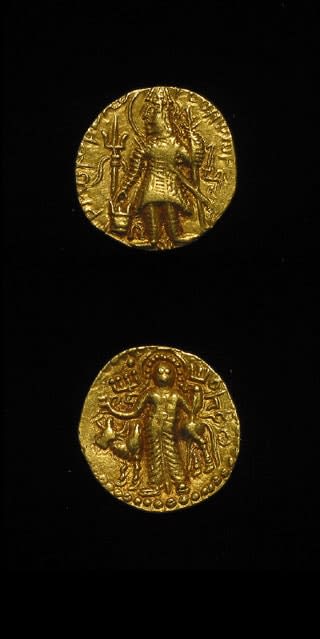Kushan Gold Dinar of Emperor Kanishka II, 225 CE - 240 CE
Gold
C.4084
Further images
Obverse: Kanishka standing left, holding a scepter, sacrificing at altar, trident standard behind. Reverse: Shiva standing facing, holding trident and diadem, the bull Nandi standing behind; tamgha above. The ancient...
Obverse: Kanishka standing left, holding a scepter, sacrificing at altar, trident standard behind.
Reverse: Shiva standing facing, holding trident and diadem, the bull Nandi standing behind; tamgha above.
The ancient region of northeastern Afghanistan and northwestern Pakistan was situated at a confluence of trading paths along the Silk Route, an area was flooded in cultural influences ranging from Greece to China. After the conquests of Alexander the Great, the creation of Greco-Bactrian kingdoms, and the general Hellenization of the subcontinent, Western aesthetic tastes became prominent. Greek influence began to permeate into the arts and culture. Eventually, the Bactrian Kingdom was absorbed by the nomadic Kushan tribes, who settled in the region and went on to establish their own dynasty. The area flourished under the Kushans and their greatest emperor, Kanishka, who i traditionally given credit for further spreading the philosophies of Buddhism throughout Central Asia and into China. This period is viewed as one of the most important eras in the history of Buddhism.
How many hands have touched a coin in your pocket or your purse? What eras and lands have the coin traversed on its journey into our possession? As we reach into our pockets to pull out some change, we rarely hesitate to think of who touched the coin before us, or where the coin will venture to after us. More than money, coins are a symbol of the state that struck them, of a specific time and place, whether contemporary currencies or artifacts of long forgotten empires. This stunning hand-struck coin reveals an expertise of craftsmanship and intricate sculptural detail that is often lacking in contemporary machine-made currencies. The iconography of this coin, featuring the emperor offering a sacrifice at an altar on the obverse and a representation of Shiva on the reverse, is related to earlier examples first struck under Emperor Vima, who revolutionized Kushan currency by introducing gold in addition to the standard copper coinage. The pantheon of gods and goddesses represented on the coins, including Greek, Bactrian, Hindu, and Zoroastrian deities in addition to the Buddha, are indicative of the culturally diverse empire the Kushan ruled over. This coin is a memorial to an ancient emperor and his empire passed from the hands of civilization to civilization, from generation to generation that still appears as vibrant today as the day it was struck.
Reverse: Shiva standing facing, holding trident and diadem, the bull Nandi standing behind; tamgha above.
The ancient region of northeastern Afghanistan and northwestern Pakistan was situated at a confluence of trading paths along the Silk Route, an area was flooded in cultural influences ranging from Greece to China. After the conquests of Alexander the Great, the creation of Greco-Bactrian kingdoms, and the general Hellenization of the subcontinent, Western aesthetic tastes became prominent. Greek influence began to permeate into the arts and culture. Eventually, the Bactrian Kingdom was absorbed by the nomadic Kushan tribes, who settled in the region and went on to establish their own dynasty. The area flourished under the Kushans and their greatest emperor, Kanishka, who i traditionally given credit for further spreading the philosophies of Buddhism throughout Central Asia and into China. This period is viewed as one of the most important eras in the history of Buddhism.
How many hands have touched a coin in your pocket or your purse? What eras and lands have the coin traversed on its journey into our possession? As we reach into our pockets to pull out some change, we rarely hesitate to think of who touched the coin before us, or where the coin will venture to after us. More than money, coins are a symbol of the state that struck them, of a specific time and place, whether contemporary currencies or artifacts of long forgotten empires. This stunning hand-struck coin reveals an expertise of craftsmanship and intricate sculptural detail that is often lacking in contemporary machine-made currencies. The iconography of this coin, featuring the emperor offering a sacrifice at an altar on the obverse and a representation of Shiva on the reverse, is related to earlier examples first struck under Emperor Vima, who revolutionized Kushan currency by introducing gold in addition to the standard copper coinage. The pantheon of gods and goddesses represented on the coins, including Greek, Bactrian, Hindu, and Zoroastrian deities in addition to the Buddha, are indicative of the culturally diverse empire the Kushan ruled over. This coin is a memorial to an ancient emperor and his empire passed from the hands of civilization to civilization, from generation to generation that still appears as vibrant today as the day it was struck.





